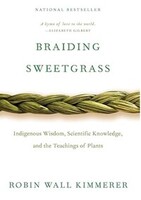Book notes: Braiding Sweetgrass
Jul 18, 2024
By Robin Wall Kimmerer.
This book has floated around the house for a bit, and is currently 222 weeks on the NYTimes best seller paperback nonfiction list.
Scoring:
- Axe for the frozen sea: 7/10.
- Page count: 384. Effective page count depended on the chapter, some were breathtakingly fast, some really slow.
The book is a collection of essays covering what the book subtitle suggests: “Indigenous Wisdom, Scientific Knowledge, and the Teachings of Plants”.
The prose was brilliant, though it was ocassionally was too flowery for my taste.
Each chapter hit a different way. I greatly enjoyed a few of them, generally enjoyed most of them, but skipped along with a few of them. Maybe in the future with “essay collection” books I’ll track that.
Plants have a lot to teach us if we pay attention. The author got a PhD in botany, but then discovered there was a lot to learn from Indigenous Wisdom.
Only harvest half of what’s available in the wild at a given spot. Some plants (sweetgrass) depend on harvests. Grasses depend on animals eating them.
I’m just now learning about the “three sisters” in American agriculture technique: corn, beans, and squash. They help each other grow and keep the soil rich in nitrogen. You can mix the types of each to get variety. I learned the Aztecs were doing this as well on our recent trip to Mexico.
My favorite story was the author’s quest to turn the spring-fed pond on her farm from a mucky green slimy mess into a clear blue pond because she and her daughters wanted to swim in it. She pulled the plants that grew in the pond, let them dry for a day or so, then hauled them out of the watershed. She did it with spare bits of time she had from being a professor and a single mom. It took a couple of decades (the kids were out of the house by then), but she did it. I enjoy hearing about personal quests like this! What is the pond-clearing job in my life? Hmmm.
Onandaga Lake had a century of raw sewage and industrial dumping and is a superfund site. At some point people had to make decisions like “where should we dump this industrial waste?” and dumped it in the lake. Onandaga Lake cleanup plan dredged and capped the contaminants for $500 million, though Onandaga Nation wasn’t completely satisfied and had their own $2 billion plan. Lesson learned: an ounce of prevention is woth a pound of cure. Good news: the plants and wildlife are starting to reclaim the lake, and the water is cleaner than it has been in 100 years.
Bottom line: this book that should be on everyone’s reading list, but you can skip the chapters that don’t spark joy.